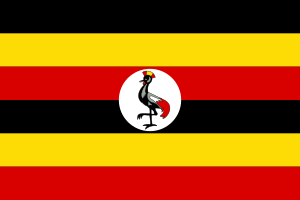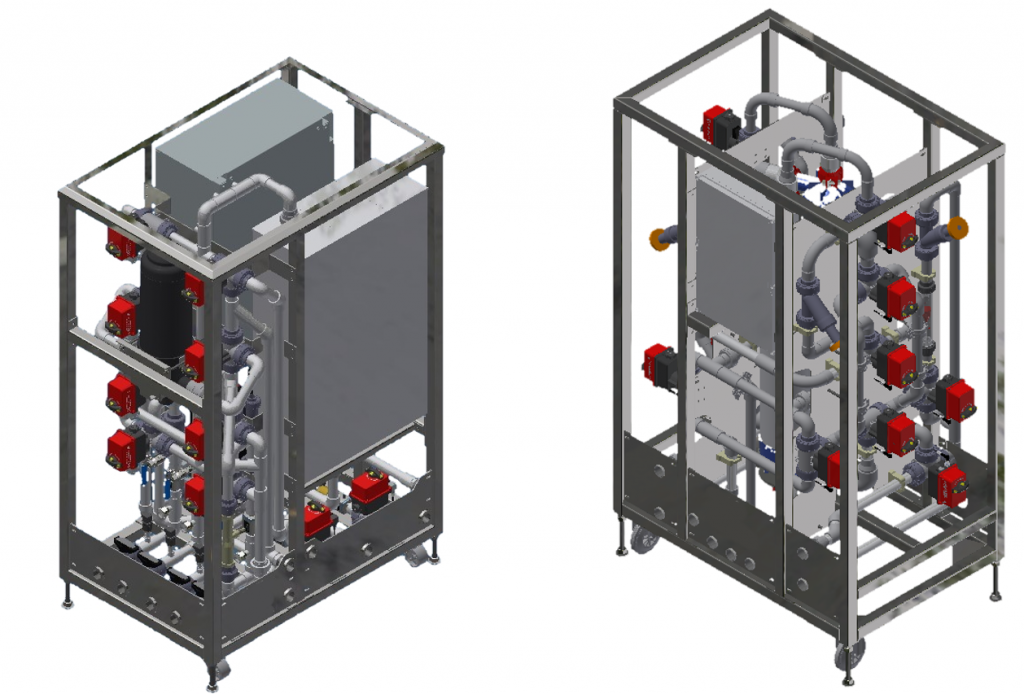
THE DEVELOPMENT OF WATER MANAGEMENT SYSTEMS IN THE REPUBLIC OF UGANDA PROJECT
TECHNOLOGY
The water treatment unit of the investment project consists of the following sub-units:
- Raw water connection and pre-treatment
- Pre-filtration and ultrafiltration
- Chemical dosing system
- Backwash and CIP unit
Raw water connection and pre-treatment
The raw water coming from the boreholes – depending on the actual solar conditions and raw water pump performance – can be directed:
- Directly to the filtration technology
- Via booster pump to the filtration technology
- Into the internal tank (200l)
In the internal tank coagulation can be made to increase effectiveness of filtration technology. The same tank is used temporarily for intense chemical flushing.
Beside the dual pressurized water inlet from boreholes, there are connections for water supply network, or delivery truck. In this case the built-in booster pump can be used to drive the filtration system, post-processing and disinfecting the supply coming from other sources.
According to our previous lab tests, the raw water doesn’t contain hard treatable impurities, but the pH value is a little low – in some cases below 6. It must be raised back to around pH 7 with the use of chemical. For this reason, for example Na2CO3 solution is supposed to be dosed.
The second process pump – beside the backwash and CIP operations can be used as a booster for remote external tanks. The speed of the pumps is controlled with variable frequency drive according the needed, adjusted flowrate.
Pre-filtration and ultrafiltration
There is no need for special chemical treatment besides adjustment of pH value. The heart of the technology to provide safe drinking water is membrane technology, using ultrafiltration. Prior ultrafiltration a safety filter, like a disc filter is advised to be installed to keep the eventually occurring solid particles from water and prevent any damage of the ultrafilter. The disc filter has to be cleaned in a hydraulic way (backwashed), for this purpose it is equipped with 3-way ball valves with L-shape bores.
The suggested type of ultrafilter has a pore size of 10nm. This is very tiny, also among the different ultrafilter types. The most important purpose of the ultrafiltration is that it provides safety against protozoa and bacteria contamination. It can be interpreted like the first barrier of disinfection. Ultrafiltration has many more advantages, like it is moderately resistant to chlorine and other oxidants which makes possible to use higher concentration system disinfection. The ultrafilter column is equipped with the necessary shut-off valves, that enable the different operating statuses such as filtration, backwash, chemical enhanced backwash, cleaning-in-place. Both cross-flow and dead end filtration is possible.

Production design of DF and UF racks
Chemical dosing system
Basically only two chemical has to be added to the raw water. Previously the low pH value has been mentioned, that shall be increased by dosing of sodium carbonate solution.
The second chemical that has to be dosed to the water is the disinfectant sodium hypochlorite solution. For this dosage two separated pumps shall be installed. It is necessary to have the possibility to add chlorine to the backwash tank, so the chemical enhanced backwash can be carried out both in the disc filter and in the ultrafilter. The second pump dispenses the chemical to the water stream and makes the process disinfection throughout the whole system. An optional third pump can be used as a final adjustment to the chlorine level.
The pumps dose according to proportional value of water flow rate. The specific dosage can be adjusted on the automatic system (PLC).
Backwash and CIP unit
The ultrafilter has to be maintained sometimes – if the transmembrane pressure reaches a determined value – with chemical cleaning, so called cleaning in place (CIP). During this operation the caustic chemical must be added to the backwash water tank manually, or using one of the multi-function dosing pumps, and the solution has to be circulated with the process pump. The same action has to be repeated with acid to remove the precipitation form after caustic cleaning.


